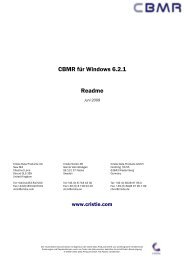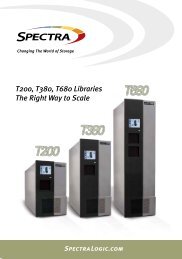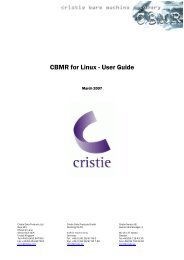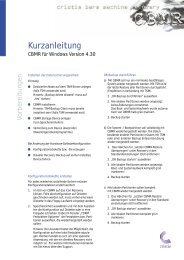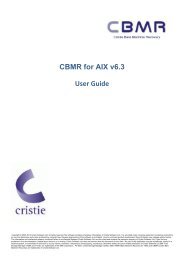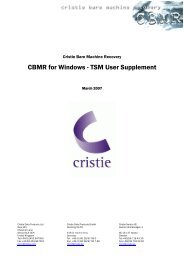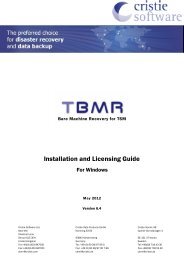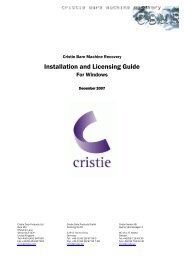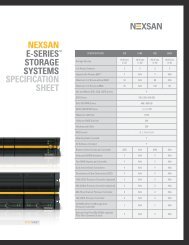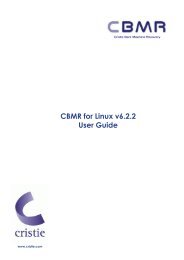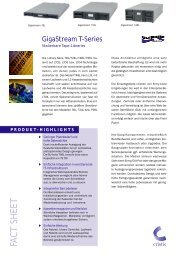CBMR 6.1 for HP-UX PA-RISC Systems - Cristie Data Products GmbH
CBMR 6.1 for HP-UX PA-RISC Systems - Cristie Data Products GmbH
CBMR 6.1 for HP-UX PA-RISC Systems - Cristie Data Products GmbH
You also want an ePaper? Increase the reach of your titles
YUMPU automatically turns print PDFs into web optimized ePapers that Google loves.
www.cristie.com<br />
<strong>CBMR</strong> <strong>6.1</strong> <strong>for</strong> <strong>HP</strong>-<strong>UX</strong><br />
<strong>PA</strong>-<strong>RISC</strong> <strong>Systems</strong><br />
Software Version: <strong>6.1</strong><br />
Date Published: November 2009
Contents<br />
Page 2<br />
<strong>CBMR</strong> <strong>for</strong> <strong>HP</strong>-<strong>UX</strong> <strong>PA</strong>-<strong>RISC</strong> Version: <strong>6.1</strong><br />
Section No. Section Title Page<br />
1.0 Introduction 3<br />
1.1 Why should I read this document? 3<br />
1.2 Overview 3<br />
2.0 How to use <strong>CBMR</strong> 3<br />
2.1 Requirements 3<br />
2.2 Licensing 4<br />
2.3 Setup 4<br />
2.3.1 Check TSM Client 4<br />
2.3.2 Installation 5<br />
2.3.3 Creating a TSM Client Node 6<br />
2.3.3.1 Creating a dedicated node via the TSM client 6<br />
2.3.3.2 Additional configuration to maintain multiple backup versions 7<br />
2.4 Configuring <strong>CBMR</strong> 7<br />
2.4.1 Create default backup location 8<br />
2.4.2 Store machine configuration data 10<br />
2.4.3 Create DR bootable media 11<br />
2.4.4 Do regular system backups 11<br />
2.4.5 Testing the disaster recovery media 13<br />
2.5 Per<strong>for</strong>ming a Disaster Recovery 22<br />
2.5.1 Recovering the system 22<br />
Copyright © 2003-2009 <strong>Cristie</strong> Software Ltd. All rights reserved.<br />
The software contains proprietary in<strong>for</strong>mation of <strong>Cristie</strong> Software Ltd.; it is provided under a license agreement containing restrictions on use and<br />
disclosure and is also protected by copyright law. Reverse engineering of the software is prohibited.<br />
Due to continued product development this in<strong>for</strong>mation may change without notice. The in<strong>for</strong>mation and intellectual property contained herein is<br />
confidential between <strong>Cristie</strong> Software Ltd. and the client and remains the exclusive property of <strong>Cristie</strong> Software Ltd. If you find any problems in the<br />
documentation, please report them to us in writing. <strong>Cristie</strong> Software Ltd. does not warrant that this document is error-free.<br />
No part of this publication may be reproduced, stored in a retrieval system, or transmitted in any <strong>for</strong>m or by any means, electronic, mechanical,<br />
photocopying, recording or otherwise without the prior written permission of <strong>Cristie</strong> Software Ltd.<br />
IBM Tivoli Storage Manager (TSM) and TIVOLI are trademarks of the IBM Corporation.<br />
PC-BaX, <strong>Cristie</strong> Storage Manager (CSM), SDB, TBMR (Bare Machine Recovery <strong>for</strong> TSM) and <strong>CBMR</strong> (<strong>Cristie</strong> Bare Machine Recovery) are trade-<br />
marks of <strong>Cristie</strong> Software Ltd.<br />
<strong>Cristie</strong> Software Ltd<br />
New Mill, Chestnut Lane<br />
Stroud GL5 3EH UK<br />
+44 (0) 1453 847000 Internet E-Mail: cbmr@cristie.com<br />
Website: http://www.cristie.com
1.0 Introduction<br />
1.1 Why should I read this document?<br />
Page 3<br />
<strong>CBMR</strong> <strong>for</strong> <strong>HP</strong>-<strong>UX</strong> <strong>PA</strong>-<strong>RISC</strong> Version: <strong>6.1</strong><br />
Please take a moment to review this Quick Start Guide be<strong>for</strong>e using <strong>CBMR</strong> (<strong>Cristie</strong> Bare Machine<br />
Recovery) version <strong>6.1</strong> in your <strong>HP</strong>-<strong>UX</strong> <strong>PA</strong>-<strong>RISC</strong> environment <strong>for</strong> the first time. It will save you time and<br />
will reduce installation problems. <strong>CBMR</strong> is not an off-the-shelf program that you can install on your system<br />
and run straight away!<br />
This is a Quick Start Guide so only typical examples of the use of <strong>CBMR</strong> are provided. Refer to the<br />
individual man pages <strong>for</strong> detailed help on the <strong>CBMR</strong> component programs.<br />
Be<strong>for</strong>e installation, you must check the availability of certain services and protocols which <strong>CBMR</strong> will<br />
require during the setup of servers and clients and during the restore of a downed machine. Some system<br />
administration experience is required to per<strong>for</strong>m these one time tasks.<br />
1.2 Overview<br />
<strong>CBMR</strong> allows a crashed system to be recovered providing you have made sensible provision in advance.<br />
<strong>CBMR</strong> consists of the following components or modules:<br />
• A backup and restore module (ubax) which allows you to backup system files. ubax is provided<br />
with 2 <strong>for</strong>ms of user interface: command line or ‘curses’ based (gubax). The User may choose whichever<br />
<strong>for</strong>m is convenient. This guide shows examples using the curses based interface (refer to the<br />
screen-shots shown).<br />
• A disaster recovery (DR) module which stores machine configuration data and recovers a crashed<br />
system using a custom built minimal <strong>HP</strong>-<strong>UX</strong> <strong>PA</strong>-<strong>RISC</strong> operating system.<br />
• An IBM Tivoli Storage Manager (TSM) support module (if required) that allows you to back up TSM<br />
client systems to TSM servers.<br />
Please note that this version of <strong>CBMR</strong> does NOT require the use of an <strong>HP</strong> Ignite-<strong>UX</strong> server <strong>for</strong> disaster<br />
recovery purposes.<br />
You may backup to and restore from any suitable device available on your system. This might be <strong>for</strong><br />
example:<br />
• A tape (on its own or in a library)<br />
• A <strong>Cristie</strong> Virtual Tape Device (VTD) file (on a network server)<br />
• A TSM Node/Filespace.<br />
2.0 How to use <strong>CBMR</strong><br />
<strong>CBMR</strong> can protect a system all the time, if setup and configured correctly. The following sections explain<br />
the basic procedure.<br />
2.1 Requirements<br />
<strong>CBMR</strong> <strong>for</strong> <strong>HP</strong>-<strong>UX</strong> on <strong>PA</strong>-<strong>RISC</strong> can be installed on any <strong>HP</strong>-<strong>UX</strong> 11.23 or 11.31 <strong>PA</strong>-<strong>RISC</strong> machine (32 or 64bit).<br />
If TSM is to be used, your system should have an appropriate 64-bit TSM API client already installed.<br />
To create bootable D.R ISOs the third party product CDRecord is required to be installed.<br />
Note recovery requires at least 64MB RAM.
2.2 Licensing<br />
Page 4<br />
<strong>CBMR</strong> <strong>for</strong> <strong>HP</strong>-<strong>UX</strong> <strong>PA</strong>-<strong>RISC</strong> Version: <strong>6.1</strong><br />
Production use of <strong>CBMR</strong> requires a license to be purchased from <strong>Cristie</strong>. The fully working product is<br />
however provided <strong>for</strong> free evaluation <strong>for</strong> a period up to 30 days. Use beyond that period requires that a<br />
<strong>CBMR</strong> <strong>for</strong> <strong>HP</strong>-<strong>UX</strong> license be purchased from <strong>Cristie</strong> or its partners.<br />
2.3 Setup<br />
You must follow the procedure in the order listed below. <strong>CBMR</strong> can be used with or without a TSM server.<br />
You may omit the steps involving TSM configuration if you use <strong>CBMR</strong> with a directly attached storage<br />
device or a VTD on a remote share.<br />
1. Check TSM Client Version.<br />
2. Install <strong>CBMR</strong>.<br />
3. Create an TSM Client node.<br />
4. Create a default TSM or VTD Backup Location.<br />
5. Configure <strong>CBMR</strong>.<br />
6. Store machine configuration data.<br />
7. Create DR bootable media.<br />
8. Per<strong>for</strong>m regular system backups.<br />
9. If encryption is used, copy the key repository file somewhere safe.<br />
To per<strong>for</strong>m a Bare Machine Recovery you must:<br />
1. Boot up the machine to be restored from the previously prepared DR bootable media.<br />
2. Specify the location of the machine configuration data.<br />
3. Per<strong>for</strong>m a backup recovery from <strong>CBMR</strong>.<br />
2.3.1 Check the TSM Client<br />
If you are not using TSM, skip this step.<br />
It is important to check the version of the TSM Client installed on your machine. TSM Client compatibility<br />
is:<br />
<strong>HP</strong>-<strong>UX</strong> version 11.23 & 11.31 - client versions 5.1.x through to <strong>6.1</strong>.0<br />
Only clients with a compatible TSM Server are supported by <strong>CBMR</strong>. To check use the <strong>HP</strong>-<strong>UX</strong> command:<br />
swlist TIVsm<br />
This will produce output like the example shown below.
2.3.2 Installation<br />
Page 5<br />
<strong>CBMR</strong> <strong>for</strong> <strong>HP</strong>-<strong>UX</strong> <strong>PA</strong>-<strong>RISC</strong> Version: <strong>6.1</strong><br />
The installation depot can be downloaded from the <strong>Cristie</strong> website at http://www.cristie.com or can be<br />
found in the install directory on the <strong>CBMR</strong> <strong>for</strong> <strong>HP</strong>-<strong>UX</strong> <strong>PA</strong>-<strong>RISC</strong> CD-ROM.<br />
<strong>CBMR</strong> installation requires the standard <strong>HP</strong>-<strong>UX</strong> installation utility swinstall. This is required in order to<br />
install the <strong>CBMR</strong> depot. Use the following command to install <strong>CBMR</strong>:<br />
swinstall -s/tmp/cbmr-1.3.11_<strong>HP</strong>-<strong>UX</strong>_11.23.depot \* (<strong>for</strong> <strong>HP</strong>-<strong>UX</strong> 11.23)<br />
To uninstall <strong>CBMR</strong>, use:<br />
swremove <strong>CBMR</strong><br />
The installation process will install the following programs/utilities:<br />
Program/Utility User/System Component Description<br />
dr System/DR Curses <strong>CBMR</strong> DR program<br />
cbmrcfg User/Prep Write configuration prior to DR<br />
make_cbmr User/Prep Create <strong>CBMR</strong> recovery media<br />
<strong>for</strong>mat_floppy User/Prep Create <strong>for</strong>matted floppy disk<br />
showdevs User/Prep/DR List currently installed CD/DVD/Tape/<br />
Floppy devices<br />
ubax User/System Prep/DR <strong>Cristie</strong> backup/restore program<br />
gubax User/Prep Curses version of Ubax<br />
show_routes System/DR Show network routes in DR environment.<br />
(Note: <strong>for</strong>mat_floppy is present but not used).<br />
In addition, a detailed discussion of each component is provided by installed man pages. Finally, a<br />
readme.txt file containing late breaking news and User Guides (including this guide) can be found in the<br />
directory: /etc/cristie.
2.3.3 Creating a TSM Client Node<br />
If you are not using TSM, skip this step.<br />
Page 6<br />
<strong>CBMR</strong> <strong>for</strong> <strong>HP</strong>-<strong>UX</strong> <strong>PA</strong>-<strong>RISC</strong> Version: <strong>6.1</strong><br />
<strong>CBMR</strong> will connect to an TSM server as a client node and the machine’s operating system files and other<br />
important files should be stored under a Filespace under the client Node. If you need to create a Client<br />
Node using the TSM Admin Client, refer to the TSM Administrator Guide <strong>for</strong> further in<strong>for</strong>mation.<br />
Note that a valid license must be installed <strong>for</strong> the TSM component of <strong>CBMR</strong>. A 30-day trial license is<br />
provided.<br />
2.3.3.1 Creating a dedicated node via the TSM Admin client<br />
To use the TSM module, you must enable ubax to backup to the IBM Tivoli Storage Manager by creating a<br />
dedicated node via the TSM Admin client.<br />
The settings required <strong>for</strong> the node are:<br />
Archive Delete Allowed Yes<br />
Backup Delete Allowed Yes<br />
Client Compression Setting Client<br />
Force Password Reset No<br />
Node Type Client<br />
In addition, you must consider your password policy. If you specify a Password Expiration period, you will<br />
have to set the password in ubax every time the password expires.<br />
The automatic password generation <strong>for</strong> the client nodes is supported (contact <strong>Cristie</strong> <strong>for</strong> details on how to<br />
do this).
2.3.3.2 Additional configuration to maintain multiple backup versions<br />
Page 7<br />
<strong>CBMR</strong> <strong>for</strong> <strong>HP</strong>-<strong>UX</strong> <strong>PA</strong>-<strong>RISC</strong> Version: <strong>6.1</strong><br />
If it is required to hold more than 1 version of the DR backup in the same filespace then the node must be<br />
setup correctly to support this. You must have a Management Class (MC), which contains a Backup Copy<br />
Group (BCG) and an Archive Copy Group (ACG).Your node needs to be registered to use the MC.<br />
The parameters of the BCG of interest are:<br />
Versions <strong>Data</strong> Exists = 2<br />
Versions <strong>Data</strong> Deleted = 1<br />
Retain Extra Versions = 30<br />
Retain Only Version = 60<br />
In this example, there can be 2 versions of an object, the Versions <strong>Data</strong> Deleted attribute specifies the<br />
maximum number of different backup versions (1 in this case) retained <strong>for</strong> files and directories that you<br />
erased from your file system. This parameter is ignored as long as the file or directory remains in your file<br />
system.<br />
The expiration date <strong>for</strong> the remaining versions is based on the retain extra versions and retain only<br />
version parameters. In the example, if there is more than one version and one is deleted, the deleted one<br />
will be kept <strong>for</strong> 30 days. The only remaining copy of the object will be retained <strong>for</strong> 60 days (that is AFTER<br />
you make it inactive).<br />
2.4 Configuring <strong>CBMR</strong><br />
The heart of <strong>CBMR</strong> is the <strong>Cristie</strong> UBax Backup and Recovery software (ubax). You need to create a<br />
Backup Location using the ubax New Backup Location option. If you are familiar with the ubax<br />
command line use that. If you are new to ubax, launch the curses based version gubax. Refer to the<br />
ubax and gubax man pages <strong>for</strong> more in<strong>for</strong>mation regarding device creation.<br />
There is also extensive online man page help <strong>for</strong> ubax and gubax.<br />
It is important that the basic steps in setting up the DR components are carried out in the correct order.<br />
That is:<br />
1. Create Backup Location(s) - use the ubax/gubax utility<br />
2. Create the DR configuration - use the cbmrcfg utility<br />
3. Create DR backups - use the ubax/gubax utility<br />
4. Create bootable media.<br />
If, <strong>for</strong> example, you create the DR configuration be<strong>for</strong>e the Backup Locations the DR process will<br />
fail. In this case the configuration will not contain the Backup Location details.
2.4.1 Create default Backup Location<br />
Page 8<br />
<strong>CBMR</strong> <strong>for</strong> <strong>HP</strong>-<strong>UX</strong> <strong>PA</strong>-<strong>RISC</strong> Version: <strong>6.1</strong><br />
Use the gubax program option 4 to create the location of the default backup location. In this example<br />
we are using TSM to hold the disaster recovery backup.<br />
Then select option 6 of the Backup Locations menu to setup the TSM server details.<br />
This results in the following screen where you can enter the TSM server details. Note that the<br />
ServerName field corresponds to the name of the corresponding entry in the TSM dsm.sys file. Note<br />
also, dsm.sys is normally found in: /opt/tivoli/tsm/client/api/bin64
The contents of a sample TSM dsm.sys is shown below:<br />
Page 9<br />
<strong>CBMR</strong> <strong>for</strong> <strong>HP</strong>-<strong>UX</strong> <strong>PA</strong>-<strong>RISC</strong> Version: <strong>6.1</strong><br />
Return to the Backup Locations menu and select option 2: ‘Create New Backup Location’.<br />
Complete the TSM node and filespace details as in the following example:
Page 10<br />
<strong>CBMR</strong> <strong>for</strong> <strong>HP</strong>-<strong>UX</strong> <strong>PA</strong>-<strong>RISC</strong> Version: <strong>6.1</strong><br />
The ServerName field must much that defined in the TSM server setup (see above). Note the last Backup<br />
Location added will always become the <strong>CBMR</strong> default. The TSM Backup Location is now fully defined.<br />
2.4.2 Store machine configuration data<br />
<strong>CBMR</strong> relies heavily on the machine configuration data to be able to restore the network configuration,<br />
recreate the volume groups, logical volumes and file systems and to restore other operating system related<br />
data. The configuration data can be either stored in the backup itself or on a network share. You only<br />
need to do it once, but you must do it again every time you change your hardware configuration.<br />
Storing the system configuration in<strong>for</strong>mation on a network share could be useful if a large number of servers<br />
are running <strong>CBMR</strong>. You can create a new share or use an existing share. If using an existing share,<br />
create a directory <strong>for</strong> <strong>CBMR</strong> so that <strong>CBMR</strong> stores its in<strong>for</strong>mation in this directory.<br />
All <strong>CBMR</strong> utilities discussed in this section are provided with ‘man’ page help.<br />
Use the cbmrcfg utility to store the machine configuration data. For example to save the configuration<br />
with the backup enter this command:<br />
cbmrcfg<br />
This will by default place the configuration data into a folder named <strong>CBMR</strong>CFG/ in the root.<br />
This effectively stores the configuration data with the backup itself (usually the most convenient). It may<br />
optionally also be saved to a network share.<br />
This may take a few moments, but successful completion is signified by:<br />
The contents of the /<strong>CBMR</strong>CFG/ folder contains the following files:<br />
When a subsequent backup is made this folder will get backed up. During a DR sequence this folder and<br />
its contents will be extracted be<strong>for</strong>e the main backup is restored to configure disks/partitions etc. first.<br />
If saving the configuration to an NFS share, mount it first and then run the cbmrcfg tool. For example:<br />
mount -F nfs 10.2.1.21:/mnt/hdc1 /cristie_nfs<br />
cbmrcfg -s /cristie_nfs<br />
where /cristie_nfs is the mount point of the share.<br />
Other locations <strong>for</strong> the configuration are potentially CD, DVD or tape, but are rarely used in practice.
2.4.3 Create DR bootable media<br />
This is per<strong>for</strong>med using the command line utility make_cbmr, e.g.:<br />
Page 11<br />
<strong>CBMR</strong> <strong>for</strong> <strong>HP</strong>-<strong>UX</strong> <strong>PA</strong>-<strong>RISC</strong> Version: <strong>6.1</strong><br />
This example creates and saves the bootable <strong>CBMR</strong> image to a network share. The final DR ISO can be<br />
found on the share called cbmr..iso e.g. cbmr.buffy.iso in this example.<br />
Other options include CD, DVD and tape but are rarely used. This ISO should be burnt to a suitable CD<br />
perhaps on a PC if CD burning software is not available on the <strong>HP</strong>-<strong>UX</strong> server.<br />
2.4.4 Do regular system backups<br />
In order to per<strong>for</strong>m a DR full backup (to TSM) straight away, enter this on the command line:<br />
ubax -b -d myTSM /etc/cristie/scripts/cbmr.scp<br />
This presupposes a <strong>CBMR</strong> TSM device myTSM has already been created and <strong>CBMR</strong> has been installed<br />
to the standard directories. The backup script used is the default provided <strong>for</strong> a DR backup. However this<br />
may be edited to include or exclude other directories as required. The default is used in this example.<br />
If it is preferred gubax can be used to per<strong>for</strong>m the DR backup instead. Always use the provided <strong>CBMR</strong><br />
script (cbmr.scp) to per<strong>for</strong>m the DR backup.<br />
Select Executive(option 1) from the gubax main menu.
Then, on the Executive menu select option 1; Backup:<br />
Page 12<br />
<strong>CBMR</strong> <strong>for</strong> <strong>HP</strong>-<strong>UX</strong> <strong>PA</strong>-<strong>RISC</strong> Version: <strong>6.1</strong><br />
You are then prompted <strong>for</strong> the backup script. Select the default cbmr.scp script <strong>for</strong> a DR backup.<br />
Finally, enter the media volume header details as required and press OK. The backup can be password<br />
protected if required.
The backup begins by creating the list of files to backup:<br />
At the end of the backup a summary display is shown:<br />
Page 13<br />
<strong>CBMR</strong> <strong>for</strong> <strong>HP</strong>-<strong>UX</strong> <strong>PA</strong>-<strong>RISC</strong> Version: <strong>6.1</strong><br />
Ensure that the DR backup is created regularly. It is suggested that a cron job be setup that periodically<br />
per<strong>for</strong>ms the DR backup (via the ubax command line tool). The system configuration could also be<br />
updated in the same job.<br />
2.4.5 Testing the Disaster Recovery media<br />
Be<strong>for</strong>e finally storing your Disaster Recovery Boot Media and the DR Configuration it is important to check<br />
that the Disaster Recovery process works and that the Disaster Recovery configuration and Backup device<br />
are accessible from the booted image. The tests described here follow the standard DR sequence, but<br />
will not attempt to actually per<strong>for</strong>m a full Disaster Recovery - only up to the point of testing access to the<br />
backup device.<br />
Insert the prepared Disaster Recovery CD, DVD or tape in the appropriate boot device and reboot your<br />
computer from this media.
The screen-shot below shows a typical boot sequence from CD:<br />
Page 14<br />
<strong>CBMR</strong> <strong>for</strong> <strong>HP</strong>-<strong>UX</strong> <strong>PA</strong>-<strong>RISC</strong> Version: <strong>6.1</strong><br />
When the DR system boots, follow the on-screen instructions to first select the appropriate keyboard layout<br />
<strong>for</strong> your system (see example below). By default the terminal type configured is ‘hp’. If this is not suitable<br />
<strong>for</strong> your terminal type this may be changed to ‘vt100’ if required. Do this by editing the ‘TERM = hp’ line<br />
manually be<strong>for</strong>e proceeding with the keyboard selection and pressing .
At this point the main <strong>CBMR</strong> Recovery Console menu will be displayed.<br />
Page 15<br />
<strong>CBMR</strong> <strong>for</strong> <strong>HP</strong>-<strong>UX</strong> <strong>PA</strong>-<strong>RISC</strong> Version: <strong>6.1</strong><br />
Be<strong>for</strong>e testing access to the backup ensure that the media containing the configuration is loaded if on<br />
CD. If the configuration is on a network share or contained within the backup itself this step can be ignored.<br />
<strong>CBMR</strong> requires access to the system configuration be<strong>for</strong>e it tests access to the backup. In this way it tests<br />
both the integrity of the backup and the configuration.<br />
This document describes 2 common scenarios - firstly the configuration held within a TSM backup itself<br />
and secondly the configuration held on a network share with the backup in TSM. Other examples include<br />
a configuration held within a VTD, or a configuration held on a CD, but these are not described here.<br />
Configuration data stored in a TSM backup<br />
In this example we show how to test access to a configuration held in a TSM backup.<br />
1. If the backup is held in TSM or on a remote VTD, or the configuration is held on a remote share, the<br />
network will need to be started. To do this select option 3 (Tools) on the Recovery Console main menu.<br />
On the Tools menu itself select option 1 (Configure the network). Then select option 1 (Start the<br />
network) on the Configure Network menu.
You will then be prompted <strong>for</strong> the network details as follows:<br />
If the network starts successfully the following message will be displayed:<br />
Page 16<br />
<strong>CBMR</strong> <strong>for</strong> <strong>HP</strong>-<strong>UX</strong> <strong>PA</strong>-<strong>RISC</strong> Version: <strong>6.1</strong><br />
2. With the network now operational, select option 4 on the Tools menu, (Test access to backup device).<br />
You will then be provided with the following Access Configuration menu:<br />
3. From this menu selection option 1: From a <strong>CBMR</strong> backup. You will now need to setup a Backup<br />
Location to represent the TSM backup. Be<strong>for</strong>e this is done however the TSM server details must be<br />
setup.
The next menu displayed is the Backup Locations menu:<br />
Use option 6 (Set TSM Server) on the Backup Locations menu to do this:<br />
Page 17<br />
<strong>CBMR</strong> <strong>for</strong> <strong>HP</strong>-<strong>UX</strong> <strong>PA</strong>-<strong>RISC</strong> Version: <strong>6.1</strong><br />
Now create a TSM Backup Location. Select Create New Backup Location, then TSM Backup<br />
Location. Specify the TSM node and filespace details as in the following example:
Page 18<br />
<strong>CBMR</strong> <strong>for</strong> <strong>HP</strong>-<strong>UX</strong> <strong>PA</strong>-<strong>RISC</strong> Version: <strong>6.1</strong><br />
Note that the ServerName field (Server_a in the above example) should match the name given to the<br />
TSM server setup above. successful definition of the Backup Location is signified with this message:<br />
4. Press to display a prompt <strong>for</strong> the backup media volume password:<br />
Enter the correct password <strong>for</strong> the backup.<br />
5. At this stage <strong>CBMR</strong> is just retrieving the configuration files from the backup - in this example the<br />
configuration files are contained within the TSM backup itself. The program will then check that a<br />
connection can be made with the backup device and that a valid volume header can be accessed.<br />
If the TSM backup contains several versions, an additional prompt containing the date/time of each<br />
version is displayed. Select the correct version as required.<br />
Successful retrieval of the configuration files is signified by:<br />
6. Press to continue and you will be re-prompted <strong>for</strong> both the media password and the version<br />
Select the same version date/time selected <strong>for</strong> the configuration be<strong>for</strong>e.
7. Successful access to the backup is signified by the message:<br />
Page 19<br />
<strong>CBMR</strong> <strong>for</strong> <strong>HP</strong>-<strong>UX</strong> <strong>PA</strong>-<strong>RISC</strong> Version: <strong>6.1</strong><br />
8. If this process is successful, you can select Exit and Reboot from the main menu and boot the machine<br />
back to the normal <strong>HP</strong>-<strong>UX</strong> operating system.<br />
Configuration data stored on a network share<br />
If the configuration data is held on a network share rather than external media or TSM, follow these steps.<br />
1. Select option 4 on the Tools menu - Test access to backup device. You will then be provided with the<br />
following Access Configuration menu:<br />
In this case select option 3 - From an NFS share. You will then be prompted with the server network<br />
details so that the network can be started:<br />
Successful start of the network is indicated by:
Page 20<br />
<strong>CBMR</strong> <strong>for</strong> <strong>HP</strong>-<strong>UX</strong> <strong>PA</strong>-<strong>RISC</strong> Version: <strong>6.1</strong><br />
2. You will then be required to setup details of the NFS network share as shown in the following example:<br />
Successful setup of the NFS share is indicated by:<br />
3. You will then be offered a choice of NFS shares (in cases where more than 1 have been defined):<br />
Select the appropriate share. If more than 1 server configurations are found on the network share, select<br />
the appropriate host:
Page 21<br />
<strong>CBMR</strong> <strong>for</strong> <strong>HP</strong>-<strong>UX</strong> <strong>PA</strong>-<strong>RISC</strong> Version: <strong>6.1</strong><br />
The selected server configuration files will then be copied from the network share to the local system:<br />
4. At this point <strong>CBMR</strong> will examine the configuration files to determine where the backup is held and<br />
proceed to access the backup. Now press and you will then be prompted <strong>for</strong> the backup<br />
media volume password (if any - leave blank if none).<br />
5. Our backup is held in TSM and several versions are available:<br />
Select the same version date/time selected <strong>for</strong> the configuration be<strong>for</strong>e.<br />
6. Successful access to the backup is signified by the message:<br />
7. If this process is successful, you can select Exit and Reboot from the main menu to boot the machine<br />
back to the normal <strong>HP</strong>-<strong>UX</strong> operating system.<br />
Store the DR System CD and the DR backup tape (if used) in a safe location. It is a good idea to keep<br />
more than one copy and store them in different locations. This does not apply to TSM backups.
2.5 Per<strong>for</strong>ming a Disaster Recovery<br />
Page 22<br />
<strong>CBMR</strong> <strong>for</strong> <strong>HP</strong>-<strong>UX</strong> <strong>PA</strong>-<strong>RISC</strong> Version: <strong>6.1</strong><br />
In the event of a disaster, having taken a backup of the system, <strong>CBMR</strong> enables you to restore your<br />
system back to its original state. You will need both your <strong>CBMR</strong> Disaster Recovery boot media and your<br />
DR Configuration media (if not held within the backup itself). These were created earlier.<br />
Ensure that your backup device is connected, switched on and that the device (tape/CD/DVD/TSM) is<br />
switched on and accessible. Boot the machine (or replacement machine) using the prepared <strong>CBMR</strong> boot<br />
media to display the <strong>CBMR</strong> Recovery Console main menu.<br />
2.5.1 Recovering the system<br />
The <strong>CBMR</strong> Disaster Recovery system will be booted.<br />
At the end of the boot process select the appropriate keyboard layout <strong>for</strong> your system and then choose<br />
the location of your DR configuration media. You may modify the ‘TERM = hp’ setting as the <strong>CBMR</strong><br />
Recovery Console boots to something more appropriate (e.g.’TERM = vt100’).
Page 23<br />
<strong>CBMR</strong> <strong>for</strong> <strong>HP</strong>-<strong>UX</strong> <strong>PA</strong>-<strong>RISC</strong> Version: <strong>6.1</strong><br />
After initialising the NICs (this may take a few moments), the <strong>CBMR</strong> Recovery Console main menu will<br />
then be displayed.<br />
1. Test access to the backup device first from option 4 on the Tools menu. This procedure will also<br />
require you to setup the network, specify the configuration location and the backup location.<br />
Select option 1, access configuration From a <strong>CBMR</strong> backup.<br />
2. If you are confident that the configuration data and backup device are correct and accessible, select<br />
option 1 Automatic Recovery from the main menu. You will be prompted with a caution be<strong>for</strong>e<br />
proceeding with the recovery because the next process will write to the hard drive and overwrite all the<br />
current data.
Page 24<br />
<strong>CBMR</strong> <strong>for</strong> <strong>HP</strong>-<strong>UX</strong> <strong>PA</strong>-<strong>RISC</strong> Version: <strong>6.1</strong><br />
3. Select “Yes” to proceed with the disaster recovery. The recovery actions are summarised below:<br />
• Any bootable hard disks identified in the configuration data will be made bootable.<br />
• Any physical volumes will be created.<br />
• Any volume groups will be created.<br />
• Any logical volumes will be created.<br />
• Any file systems will be created and mounted as necessary.<br />
• Any mount points will be recreated<br />
• Swap and dump will be configured.<br />
• Networks and routes will be configured.<br />
The example shows 2 TSM backup versions. Select the appropriate date/time of the backup required;<br />
ubax will then be used to restore the files. At the end of the file restore step (this could take sometime) the<br />
following message is displayed:<br />
4. Press to display:
Page 25<br />
<strong>CBMR</strong> <strong>for</strong> <strong>HP</strong>-<strong>UX</strong> <strong>PA</strong>-<strong>RISC</strong> Version: <strong>6.1</strong><br />
5. Press to return to the Recovery Console main menu. At this point, you should be able to select<br />
option 6 Exit and Reboot. However, <strong>Cristie</strong> advises that you save the recovery log files be<strong>for</strong>e doing<br />
this in case there are any boot problems. These log files will be required by <strong>Cristie</strong> Support. Select<br />
option 5: Copy log files to do this.<br />
You will be required to set up the NFS share if not already setup.<br />
Enter the share details and the log files will be copied to the share:
Page 26<br />
<strong>CBMR</strong> <strong>for</strong> <strong>HP</strong>-<strong>UX</strong> <strong>PA</strong>-<strong>RISC</strong> Version: <strong>6.1</strong><br />
6. Return to the main menu and selection Option 6 Exit and Reboot. The machine will boot and run from<br />
the hard disk.<br />
7. When the computer is operational, you will be in a state prior to the disaster, to the state when the DR<br />
backup was taken.<br />
If you have taken any other regular backups after taking the Disaster Recovery Backup, you may restore<br />
them using ubax or the respective backup software to get the most up to date in<strong>for</strong>mation back on your<br />
computer.
<strong>Cristie</strong> Software Ltd, New Mill, Chestnut Lane, Stroud GL5 3EH, U.K<br />
Tel: +44 (0)1453 847 000 Fax: +44 (0)1453 847 001 email: sales@cristie.com



